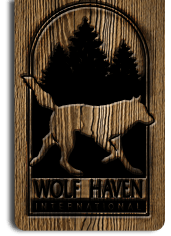Wolf Haven International facts for kids

Official logo
|
|
| Motto | Sanctuary, Education, Conservation |
|---|---|
| Formation | September 10, 1982 |
| Type | Non-governmental organization |
| Purpose | wildlife rehabilitation, Wildlife management, wolf conservation |
| Headquarters | Tenino, Washington |
|
Region served
|
International |
|
Official language
|
English |
|
Executive Director
|
Diane Gallegos |
|
Main organ
|
Board of Directors |
|
Staff
|
16 (2014) |
Wolf Haven International is a special place in Tenino, Washington, that helps wolves. It started in 1982 and was first called Wolf Haven America. This non-profit group focuses on protecting and caring for wolves.
Wolf Haven teaches people about wolves. They also run a safe home for wolves born in captivity or those who cannot live in the wild. They even help with breeding programs for very rare wolves, like the red wolf and Mexican wolf. Wolf Haven is one of only three places in the U.S. that prepares Mexican gray wolves to return to the wild.
The main refuge is 82 acres big. It is home to over 55 animals. These include gray wolves, Mexican wolves, red wolves, and even some wolfdogs and coyotes. Wolf Haven also took over another sanctuary in Montana. This means they now care for a total of 95 animals. Visitors can tour a smaller public area by making a reservation.
Contents
History of Wolf Haven
How Wolf Haven Started
Steve and Linda Kuntz are the founders of Wolf Haven International. They first got involved with wolves in 1978. They bought a wolf pup without knowing wolves were in danger. Later, they met Ed and his wife, who ran a group called Wolf Country Foundation. This group cared for eight wolves. These wolves came from research programs or a zoo that closed.
In 1980, Ed and his wife moved from Colorado. They said it was too costly to run their group there. They tried to move to Wyoming but could not bring their wolves. So, they moved to Washington state. They set up their wolf home on 4 acres in South Prairie.
Moving to a New Home
Their new neighbors, mostly ranchers, did not like the wolves. They complained the wolves were too loud. The city then made a rule that made it illegal to own wolves. So, the group moved again. They went to Tenino, Washington, near Olympia.
They found a new home on land given by someone who wanted to help. The wolf pens were far from any neighbors. This helped the group settle in and be accepted. Steve and Linda Kuntz joined them as helpers. Volunteers kept teaching people about wolves and caring for the animals. Washington state also made it illegal to own wolves later. But Wolf Haven was allowed to keep its wolves.
Becoming Wolf Haven International
In 1982, Ed and his wife gave the organization to the Kuntzes. They officially made it a non-profit group on September 10, 1982. It was called Wolf Haven America. Volunteers continued to run it. They focused on teaching people and giving homes to wolves.
By 1990, the group changed its name to Wolf Haven International. This showed their care for wolves all over the world. They also grew to have a board of directors and paid staff. Wolf Haven has given a home to over 250 wolves. These wolves were rescued from places like roadside zoos or private owners.
In 2018, Wolf Haven took over another wolf sanctuary. It was called the McCleery Buffalo Wolf Foundation in Bridger, Montana. This place is now called the McCleery Ranch. It is home to 35 wolves.
What Wolf Haven Does
Helping Wolves and People
Wolf Haven International is officially approved by important animal sanctuary groups. It is the only wolf sanctuary in the world to get global approval. This means they meet very high standards for animal care.
Wolf Haven has been featured in books. One book, "Wolf Haven: Sanctuary and the Future of Wolves in North America," has photos and stories. Another children's book, "Lobos, A Wolf Family Returns to the Wild," tells a true story. It is about Mexican gray wolves born at Wolf Haven who were released into the wild in Mexico.
Wolf Haven is known as one of the best wolf sanctuaries. When it first opened, it had 22 wolves. By 2006, it had 47 wolves. About 12,000 people visit the facility each year. The wolves at Wolf Haven live much longer than wolves in the wild. Some have lived to be 15 to 19 years old. In the wild, wolves usually live 4 to 9 years.
Wolf Haven publishes a magazine called Wolf Tracks. It shares news with people who support the organization.

